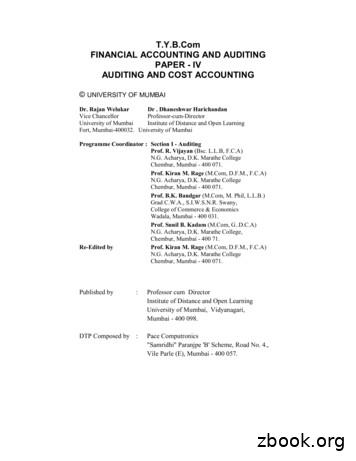Modern Auditing - Semantic Scholar
Modern Auditing:Assurance Services and the Integrityof Financial Reporting, 8th EditionWilliam C. BoyntonCalifornia Polytechnic StateUniversity at San Luis ObispoRaymond N. JohnsonPortland State UniversityChapter 14 – Auditing the Revenue Cycle
Chapter Overview
The Revenue Cycle
Develop Audit Objectives
Inherent Risk, Including the Riskof Fraud Management Misstatement of Revenue– Overstate revenues– Overstate cash and gross receivables– Understate allowance for doubtful accounts Other Misstatement Factors––––Opportunities for errorTimingMisclassificationAdjustment transactions
Analytical Procedures
Consideration of Internal ControlComponents Control Environment Risk Assessment Information and Communication Monitoring Initial Assessments of Control Risk
Control Activities for CreditSales Transactions Credit Sales Orders– Over-the-Counter– Mail Order– Internet Computerized Accounting System– General Controls– Application Controls
Common Documents andRecords Customer Order Sales Order Shipping Document– Bill of Lading– Packing Slip Sales Invoice Authorized Price List
Common Documents andRecords Sales Transactions File Sales Journal Customer Master File Accounts Receivable Master File– Accounts receivable subsidiary ledger Customer Monthly Statement
Function and Control Activities Authorizing Sales– Accepting Customer Orders– Approving Credit Delivery of Goods and Services– Filling Sales Orders– Shipping Sales Orders Recording Sales
System Flowchart – Credit Sales
System Flowchart – Credit Sales
System Flowchart – Credit Sales
Cash Receipts Transactions –Common Documents and Records Remittance Advice Prelist Cash Count Sheets Daily Cash Summary Validated Deposit Slip Cash Receipts Transactions File Cash Receipts Journal
Cash Receipts Transactions Functions Receiving Cash Receipts– Over-the-Counter Receipts– Mail Receipts Depositing Cash in Bank– Deposited intact daily Recording the Receipts
Sales Adjustment Transactions –Common Documents and Records Sales return authorization Authorization for accounts receivable write-off Receiving report Credit memo Journal entry Cash Receipts journal
Sales Adjustment Functions andControls Granting Cash Discounts Granting Sales Returns and Allowances Determining Uncollectible Accounts Other Controls Tests of Controls
Substantive Tests of AccountsReceivable Determining Detection Risk for Tests ofDetails– Existence and Occurrence– Completeness– Rights and Obligations– Valuation and Allocation– Presentation and Disclosure
Designing Substantive Tests Initial Procedures Analytical Procedures
Designing Substantive Tests Tests of Details of Transactions– Vouch Revenue Transactions– Trace Revenue Transactions– Perform Cutoff Tests Sales Cutoff Tests Sales Return Cutoff Tests– Perform Cash Receipts Cutoff Test
Designing Substantive Tests Tests of Details of Balances– Confirm Receivables– Forms of Confirmation Positive Confirmation Negative Confirmation– Timing and Extent of Requests– Controlling the Requests
Designing Substantive Tests Tests of Details of Balances– Disposition of Exceptions– Alternative Procedures for Dealingwith Nonresponses– Summarizing and Evaluating Results– Applicability to Assertions
Designing Substantive Tests Tests of Details of AccountingEstimates– Allowance for Doubtful Accounts– Aged Trial Balance Tests of Details of Disclosures
Modern Auditing: Assurance Services and the Integrity of Financial Reporting, 8th Edition William C. Boynton California Polytechnic State University at San Luis Obispo Raymond N. Johnson Portland State University Chapter 14 - Auditing the Revenue Cycle . Chapter Overview . The Revenue Cycle .
Chapter 05 - Auditing and Advanced Threat Analytics 1h 28m Topic A: Configuring Auditing for Windows Server 2016 Overview of Auditing The Purpose of Auditing Types of Events Auditing Goals Auditing File and Object Access Demo - Configuring Auditing Topic B: Advanced Auditing and Management Advanced Auditing
of Auditing and Assurance-Introduction (Auditing 1) and Auditing and Assurance-Intermediate (Auditing 2). This course is designed to provide an introduction to auditing and assurance services. Level of Proficiency in Auditing 1: Foundation Subject Learning Outcome Upon completion of the subj
SECTION-1 (AUDITING) INTRODUCTION TO AUDITING STRUCTURE: 1.1 Objectives 1.2 Introduction -an overview of auditing 1.3 Origin and evolution 1.4 Definition 1.5 Salient features 1.6 Scope of auditing 1.7 Principles of auditing 1.8 Objects of audit 1.9 Detection and prevention of fraud 1.2 1.10 Concept of " true and fair view"
5 GMP Auditing 6 GCP Auditing 7 GLP Auditing 8 Pharmacovigilance Auditing 9 Vendor/Supplier Auditing 10 Remediation 11 Staff Augmentation 12 Data Integrity & Computer System Validation . the training it needs to maintain quality processes in the future. GxP Auditing, Remediation, and Staff Augmentation The FDAGroupcom 9
Semantic Analysis Chapter 4 Role of Semantic Analysis Following parsing, the next two phases of the "typical" compiler are –semantic analysis –(intermediate) code generation The principal job of the semantic analyzer is to enforce static semantic rules –constructs a syntax tree (usua
WibKE – Wiki-based Knowledge Engineering @WikiSym2006 Our Goals: Why are we doing this? zWhat is the semantic web? yIntroducing the semantic web to the wiki community zWhere do semantic technologies help? yState of the art in semantic wikis zFrom Wiki to Semantic Wiki yTalk: „Doing Scie
(semantic) properties of objects to place additional constraints on snapping. Semantic snapping also provides more complex lexical feedback which reflects potential semantic consequences of a snap. This paper motivates the use of semantic snapping and describes how this technique has been implemented in a window-based toolkit. This
tive for patients with semantic impairments, and phono-logical tasks are effective for those with phonological impairments [4,5]. One of the techniques that focus on semantic impair-ments is Semantic Feature Analysis (SFA). SFA helps patients with describing the semantic features which ac-tivate the most distinguishing features of the semantic























